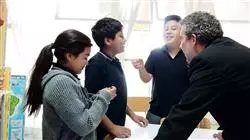University certificate
The world's largest faculty of education”
Introduction to the Program
Being familiar with and knowing how to apply conflict resolution tools is one of the differentiating skills in a quality teacher"

This program offers a comprehensive view of classroom conflict resolution. A comprehensive study of how complex relationship situations are approached, including analysis of successful models. A learning process in which you will learn about tools, experiences and advances in this field, which have been guaranteed by the program's faculty, all of whom work in this field.
The skills that a mediator possesses are the same skills that the teacher must cultivate, in order to serve as a vehicle between the student and the learning process. The teacher’s intention should be to encourage and facilitate this process, in order for students to achieve their objectives. Mediation in the educational system is an emerging element that strengthens communicative development and support systems among teachers and students, and which brings improved academic learning and balanced human growth by contemplating the relationships established in that environment.
The perspective, within the current educational paradigm, is that such action must be inclusive and based on a biopsychosocial model that considers attention to diversity from a comprehensive approach and is aimed at the entire educational community. Teachers at all educational stages and other professionals in both the educational and socio-health fields, need to know the characteristics of different students, how to identify their needs and possess the knowledge and tools that will allow them to intervene at a personal, socio-familial and, above all, educational level.
With this program, teachers will acquire skills to manage classroom conflict and diversity in the educational context, and to adjust attention to diversity and educational projects in their schools, while it will also enable them to create mediation plans for these centers.
Learn to be the trusted figure of the student body and the educational team in situations that require special handling, with this high-quality program"
This Postgraduate diploma in Classroom Conflict Resolution Techniques offers you the characteristics of a high-level teaching program that uses the latest educational technology. These are some of its most notable features:
- The latest technology in online teaching software
- Intensely visual teaching system, supported by graphic and schematic contents, easy to assimilate and understand
- Practical cases presented by practising experts
- State-of-the-art interactive video systems
- Teaching supported by telepractice
- Continuous updating and recycling systems
- Autonomous learning: full compatibility with other occupations
- Practical exercises for self-evaluation and learning verification
- Support groups and educational synergies: questions to the expert, debate and knowledge forums
- Communication with the teacher and individual reflection work
- Access to contents from any fixed or portable device with an internet connection
- Supplementary documentation databases are permanently available, even after the program
A practical and realistic program that will provide you with the tools you require to help your students, school staff and families move forward from conflicts in a positive and enriching way”
Our teaching staff is made up of working professionals. In this way TECH ensures that it delivers the educational up-to-date objectives that it aims for. A multidisciplinary and specialized teaching faculty with extensive experienced in different environments, who will develop theoretical knowledge in an efficient way, and, above all, bring practical knowledge derived from their own experience to the course: one of the differential qualities of this program.
This mastery of the subject is complemented by the effectiveness of the methodology used in the design of this course. Developed by a multidisciplinary team of e-learning experts, it integrates the latest advances in educational technology. In this way, you will be able to study with a range of comfortable and versatile multimedia tools that will give you the operability you need in your training.
The design of this program is based on Problem-Based Learning: an approach that views learning as a highly practical process. To achieve this remotely, we use telepractice: with the help of an innovative interactive video system and a Learning from an Expert approach, you will be able to acquire knowledge as if you were actually dealing with the situation you are learning about. A concept that will allow you to integrate and fix learning in a more realistic and permanent way.
A contextualized and authentic learning experience that will allow you to put your learning into practice through new skills and abilities"

Learn to make the classroom a place of development and growth by managing different contingencies skilfully and successfully"
Why study at TECH?
TECH is the world’s largest online university. With an impressive catalog of more than 14,000 university programs available in 11 languages, it is positioned as a leader in employability, with a 99% job placement rate. In addition, it relies on an enormous faculty of more than 6,000 professors of the highest international renown.

Study at the world's largest online university and guarantee your professional success. The future starts at TECH”
The world’s best online university according to FORBES
The prestigious Forbes magazine, specialized in business and finance, has highlighted TECH as “the world's best online university” This is what they have recently stated in an article in their digital edition in which they echo the success story of this institution, “thanks to the academic offer it provides, the selection of its teaching staff, and an innovative learning method aimed at educating the professionals of the future”
A revolutionary study method, a cutting-edge faculty and a practical focus: the key to TECH's success.
The most complete study plans on the university scene
TECH offers the most complete study plans on the university scene, with syllabuses that cover fundamental concepts and, at the same time, the main scientific advances in their specific scientific areas. In addition, these programs are continuously being updated to guarantee students the academic vanguard and the most in-demand professional skills. In this way, the university's qualifications provide its graduates with a significant advantage to propel their careers to success.
TECH offers the most comprehensive and intensive study plans on the current university scene.
A world-class teaching staff
TECH's teaching staff is made up of more than 6,000 professors with the highest international recognition. Professors, researchers and top executives of multinational companies, including Isaiah Covington, performance coach of the Boston Celtics; Magda Romanska, principal investigator at Harvard MetaLAB; Ignacio Wistumba, chairman of the department of translational molecular pathology at MD Anderson Cancer Center; and D.W. Pine, creative director of TIME magazine, among others.
Internationally renowned experts, specialized in different branches of Health, Technology, Communication and Business, form part of the TECH faculty.
A unique learning method
TECH is the first university to use Relearning in all its programs. It is the best online learning methodology, accredited with international teaching quality certifications, provided by prestigious educational agencies. In addition, this disruptive educational model is complemented with the “Case Method”, thereby setting up a unique online teaching strategy. Innovative teaching resources are also implemented, including detailed videos, infographics and interactive summaries.
TECH combines Relearning and the Case Method in all its university programs to guarantee excellent theoretical and practical learning, studying whenever and wherever you want.
The world's largest online university
TECH is the world’s largest online university. We are the largest educational institution, with the best and widest online educational catalog, one hundred percent online and covering the vast majority of areas of knowledge. We offer a large selection of our own degrees and accredited online undergraduate and postgraduate degrees. In total, more than 14,000 university degrees, in eleven different languages, make us the largest educational largest in the world.
TECH has the world's most extensive catalog of academic and official programs, available in more than 11 languages.
Google Premier Partner
The American technology giant has awarded TECH the Google Google Premier Partner badge. This award, which is only available to 3% of the world's companies, highlights the efficient, flexible and tailored experience that this university provides to students. The recognition as a Google Premier Partner not only accredits the maximum rigor, performance and investment in TECH's digital infrastructures, but also places this university as one of the world's leading technology companies.
Google has positioned TECH in the top 3% of the world's most important technology companies by awarding it its Google Premier Partner badge.
The official online university of the NBA
TECH is the official online university of the NBA. Thanks to our agreement with the biggest league in basketball, we offer our students exclusive university programs, as well as a wide variety of educational resources focused on the business of the league and other areas of the sports industry. Each program is made up of a uniquely designed syllabus and features exceptional guest hosts: professionals with a distinguished sports background who will offer their expertise on the most relevant topics.
TECH has been selected by the NBA, the world's top basketball league, as its official online university.
The top-rated university by its students
Students have positioned TECH as the world's top-rated university on the main review websites, with a highest rating of 4.9 out of 5, obtained from more than 1,000 reviews. These results consolidate TECH as the benchmark university institution at an international level, reflecting the excellence and positive impact of its educational model.” reflecting the excellence and positive impact of its educational model.”
TECH is the world’s top-rated university by its students.
Leaders in employability
TECH has managed to become the leading university in employability. 99% of its students obtain jobs in the academic field they have studied, within one year of completing any of the university's programs. A similar number achieve immediate career enhancement. All this thanks to a study methodology that bases its effectiveness on the acquisition of practical skills, which are absolutely necessary for professional development.
99% of TECH graduates find a job within a year of completing their studies.
Postgraduate Diploma in Conflict Resolution Techniques in the Classroom
The Postgraduate Diploma in Techniques for Conflict Resolution in the Classroom is a specialized training in the management of conflict situations in the school environment. This program offers specific tools to intervene effectively in situations that require adult mediation, either in the educational context or in the relationship with families. Conflict resolution in the classroom is fundamental to guarantee an adequate and healthy learning environment for all students. With this expert, students will gain advanced knowledge in the field of psychology and pedagogy, to be able to intervene in conflict situations effectively and promote dialogue and cooperation among students. This program is designed to equip education professionals, such as teachers, school counselors and psychologists, with the necessary skills to prevent and manage conflicts that may arise in the classroom. In addition, the expert addresses issues such as bullying, cyberbullying and other conflictive situations that can affect coexistence in the school environment.
Specialize in mediation in the school environment
The methodology of the program is innovative, with a 100% online approach that allows students to study at their own pace and from anywhere. The content of the expert is updated and is taught by professionals with extensive experience in the field of education and psychology. In short, the Postgraduate Diploma in Techniques for Conflict Resolution in the Classroom is an essential training for those education professionals who wish to acquire effective tools to intervene in conflict situations and promote a healthy and cooperative learning environment for all students.







